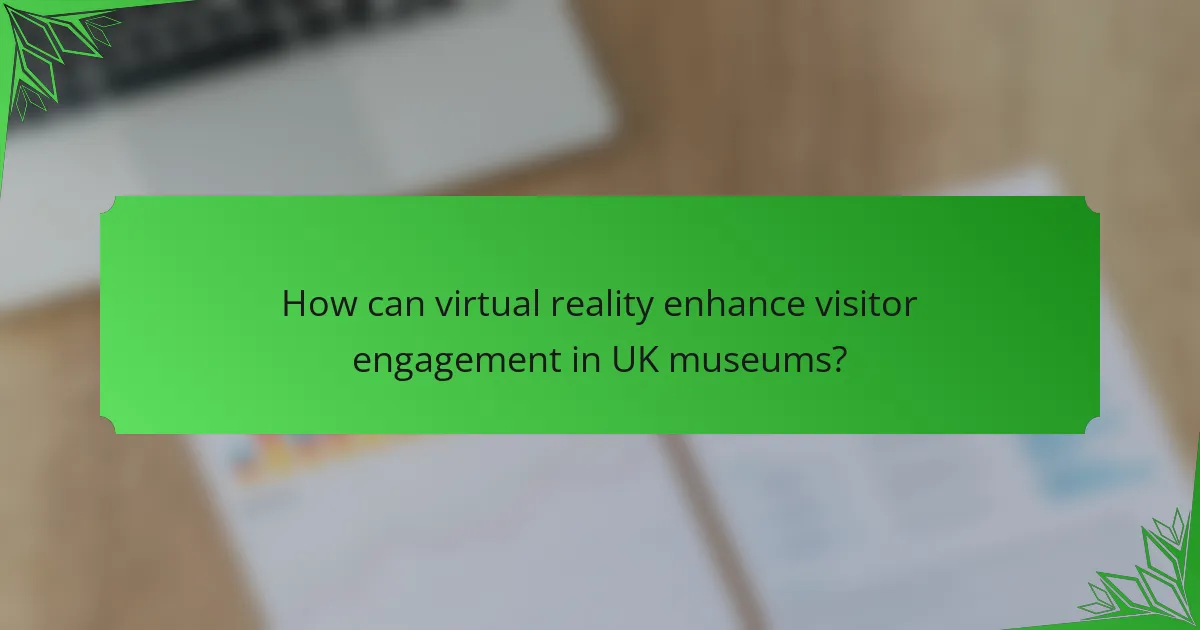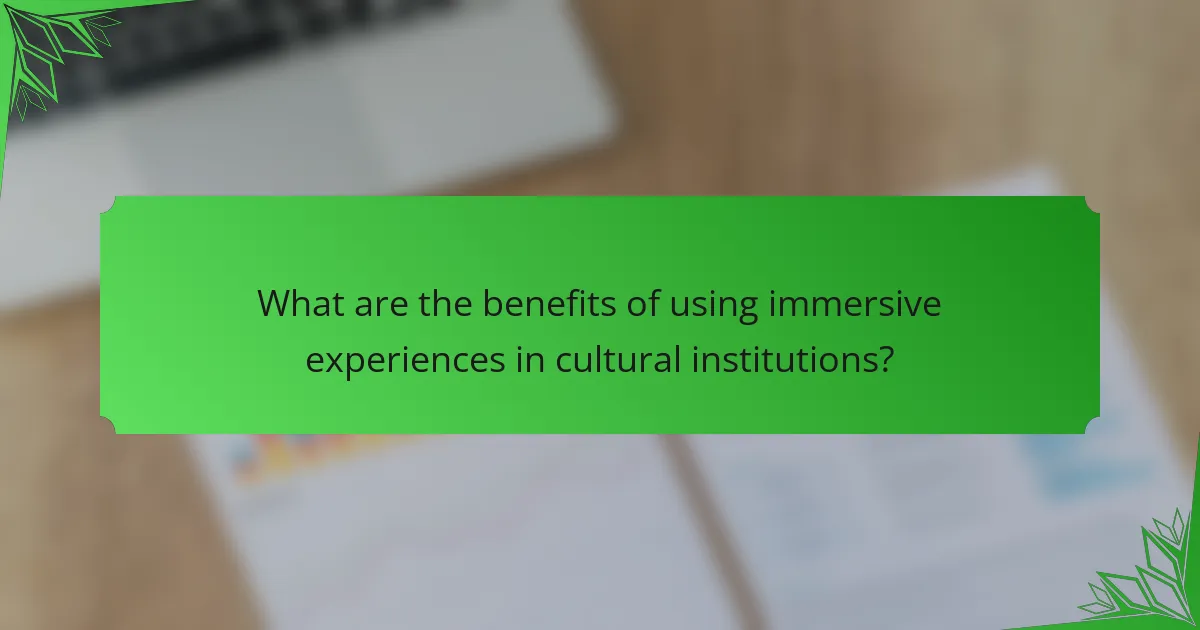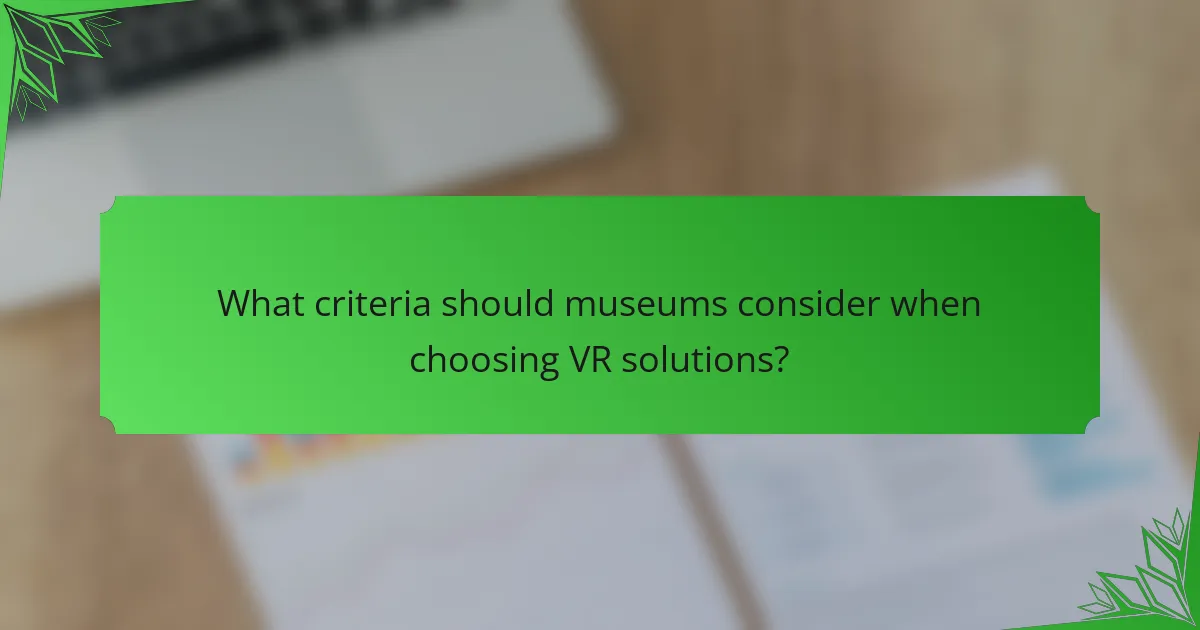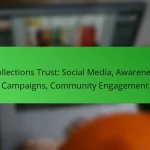Virtual reality (VR) is revolutionizing visitor engagement in UK museums by offering immersive and interactive experiences that draw audiences in. By utilizing VR technology, cultural institutions can create unique connections with exhibits, enhancing learning and retention while appealing to a broader audience.

How can virtual reality enhance visitor engagement in UK museums?
Virtual reality (VR) can significantly enhance visitor engagement in UK museums by creating immersive and interactive experiences that captivate audiences. By leveraging VR technology, museums can offer unique ways for visitors to connect with exhibits, making learning more engaging and memorable.
Immersive storytelling experiences
Immersive storytelling in VR allows visitors to step into narratives that bring history and art to life. For example, a museum could recreate historical events or artistic processes, enabling users to experience them firsthand. This approach not only captivates attention but also fosters a deeper emotional connection to the subject matter.
When designing these experiences, consider the pacing and interactivity to maintain engagement. Integrating audio, visuals, and tactile feedback can enhance the storytelling, making it more compelling and memorable for users.
Interactive exhibits
Interactive VR exhibits encourage active participation, allowing visitors to manipulate objects or explore environments in a virtual space. For instance, a science museum might let users conduct virtual experiments or interact with 3D models of complex systems. This hands-on approach can lead to higher retention of information and a more enjoyable visit.
To maximize effectiveness, ensure that the technology is user-friendly and accessible. Providing clear instructions and support can help visitors of all ages and backgrounds engage fully with the interactive elements.
Virtual tours of collections
Virtual tours using VR can provide access to museum collections that may not be physically available to visitors. This is particularly beneficial for remote audiences or those with mobility challenges. By offering guided tours through VR, museums can showcase their collections in a dynamic way, highlighting key pieces and providing context.
When implementing virtual tours, consider incorporating features like 360-degree views and informative overlays. This can enrich the experience, allowing users to explore at their own pace while gaining insights into the exhibits.

What are the benefits of using immersive experiences in cultural institutions?
Immersive experiences in cultural institutions enhance visitor engagement and create memorable interactions with exhibits. These experiences can lead to increased retention, improved educational outcomes, and a wider audience reach.
Increased visitor retention
Immersive experiences can significantly boost visitor retention by creating memorable moments that encourage repeat visits. For instance, virtual reality installations allow guests to engage with exhibits in a way that traditional displays cannot, making them more likely to return.
To maximize retention, cultural institutions should consider incorporating interactive elements that invite participation. This could include gamified experiences or personalized tours that adapt to visitor interests, fostering a deeper connection with the content.
Enhanced educational outcomes
Using immersive experiences can lead to enhanced educational outcomes by facilitating deeper understanding and retention of information. For example, virtual reality can transport users to historical events or environments, providing context that traditional methods may lack.
Institutions should align immersive content with educational goals, ensuring that experiences are not only engaging but also informative. Collaborating with educators can help develop programs that meet curriculum standards while captivating audiences.
Broader audience reach
Immersive experiences can help cultural institutions reach a broader audience by appealing to diverse demographics. By integrating technology, such as augmented reality or interactive displays, institutions can attract younger visitors who may be less inclined to engage with traditional exhibits.
To effectively broaden their audience, institutions should consider accessibility features and multilingual options. This ensures that immersive experiences are inclusive, allowing a wider range of visitors to participate and enjoy the offerings.

Which technologies are essential for creating virtual reality experiences?
Essential technologies for creating virtual reality (VR) experiences include VR headsets, 3D modeling software, and augmented reality applications. These tools enable developers to design immersive environments that engage users effectively.
VR headsets like Oculus Quest
VR headsets, such as the Oculus Quest, are crucial for delivering immersive experiences. They provide high-quality visuals and spatial audio, allowing users to feel present in a virtual environment. When selecting a headset, consider factors like resolution, field of view, and comfort for extended use.
For optimal engagement, ensure the headset supports a wide range of applications and is compatible with the latest software updates. Popular options often range from $300 to $600, depending on features and capabilities.
3D modeling software
3D modeling software is essential for creating the virtual environments users will explore. Programs like Blender, Maya, and Unity allow developers to design detailed models and animations that enhance the realism of VR experiences. Choose software that fits your skill level and project requirements.
When working with 3D models, consider the polygon count and texture resolution to maintain performance across different VR headsets. A well-optimized model can significantly improve user experience by reducing lag and enhancing visual fidelity.
Augmented reality applications
Augmented reality (AR) applications complement VR by overlaying digital information onto the real world. Tools like ARKit and ARCore enable developers to create interactive experiences that blend physical and digital elements. This technology can enhance visitor engagement by providing additional context or information in real-time.
When integrating AR into your projects, focus on user interaction and ensure that the digital content is relevant to the physical environment. This approach can increase user retention and satisfaction, making the experience more memorable.

How do UK museums implement virtual reality solutions?
UK museums implement virtual reality (VR) solutions by integrating immersive technologies to enhance visitor engagement and educational experiences. This often involves collaborations with technology firms, staff training, and securing funding to support the adoption of VR tools.
Partnerships with tech companies
Many UK museums form partnerships with technology companies to develop and implement VR experiences. These collaborations can provide access to cutting-edge technology and expertise, allowing museums to create tailored virtual experiences that resonate with their audiences.
For example, a museum might work with a VR developer to create a virtual tour of an archaeological site, enabling visitors to explore historical contexts in an engaging way. Such partnerships often lead to innovative solutions that enhance the overall visitor experience.
Training staff for VR integration
Training staff is crucial for the successful integration of VR in museums. Staff members need to understand how to operate VR equipment and guide visitors through the experiences effectively. This training can range from basic technical skills to more advanced knowledge about the content being presented.
Workshops and ongoing training sessions can help staff feel confident in using VR technology, ensuring that they can assist visitors and troubleshoot any issues that arise during the experience. This investment in staff development is key to maximizing the impact of VR solutions.
Funding and grants for technology
Securing funding is a significant consideration for UK museums looking to implement VR solutions. Many institutions seek grants from government bodies, arts councils, and private foundations that support technological innovation in cultural institutions.
Potential funding sources may include the National Lottery Heritage Fund or local arts councils, which often provide financial support for projects that enhance visitor engagement through technology. Museums should prepare detailed proposals outlining the expected benefits and educational value of their VR initiatives to increase their chances of receiving funding.

What criteria should museums consider when choosing VR solutions?
Museums should prioritize user experience, cost-effectiveness, and technical compatibility when selecting virtual reality (VR) solutions. These criteria ensure that the VR implementation enhances visitor engagement while remaining within budget and operational capabilities.
User experience design
User experience design is crucial for VR solutions as it directly impacts how visitors interact with the content. A well-designed experience should be intuitive, engaging, and accessible to a diverse audience, including those who may not be tech-savvy.
Consider elements such as ease of navigation, visual clarity, and the emotional impact of the experience. For example, VR installations that allow users to explore historical sites or artifacts in an immersive way can significantly enhance learning and retention.
Cost-effectiveness
Cost-effectiveness involves evaluating both initial investment and ongoing expenses associated with VR solutions. Museums should assess the total cost of ownership, including hardware, software, maintenance, and potential updates.
When budgeting, consider options that offer scalable solutions, allowing for gradual investment as technology evolves. For instance, a museum might start with a single VR exhibit and expand based on visitor feedback and engagement metrics, ensuring that funds are allocated efficiently.








